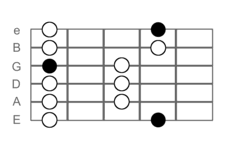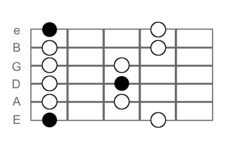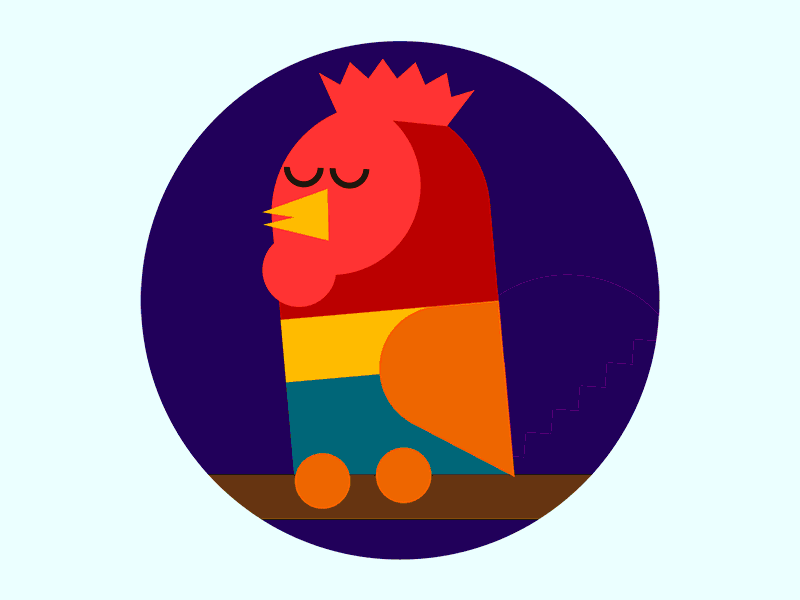Example of a Pentatonic Box Pattern – the Same Notes
Da www.guitarlessonworld.com:
Take a look at these two popular pentatonic box patterns. You’ll note that they’re the same except the root note location is 3 frets down for the minor pentatonic scale. If you’re familiar with the CAGED chords, you’ll notice that this box pattern relates to the G form and the E form respectively. I will show you the box patterns for all the CAGED forms later.


What this means is that you need to know exactly five box patterns for both scales. I will cover patterns in greater depth below.
Forming Pentatonic Scales in Parallel
Another way to form the scale is in parallel, using the same root note rather than the relative minor. In my opinion, this is useful for learning the notes of the scale rather than just the pattern. To form the scales in parallel, you can take the major scale and use the formulas in the table below.
For example, the C major scale is C-D-E-F-G-A-B. To form the C Major pentatonic scale, you would take the 1 = C, 2 = D, 3 = E, 5 = G, 6 = A. To form the C minor pentatonic scale, you would take the 1 = C, b3 = Eb, 4 = F, 5 = G, b7 = Bb. You will notice that the notes are not the same because only the relative minor pentatonic scale has the same notes. In this case, it is A minor pentatonic which is A, C, D, E, G (the same notes as C Major Pentatonic).
| Scale | Note Degrees (Based on the Major Scale) |
| Major Pentatonic | 1-2-3-5-6 |
| Minor Pentatonic | 1-b3-4-5-b7 |
Major Pentatonic Box Patterns
These are the five CAGED box patterns for the Major Pentatonic Scale. Can you pick out the major chords associated with the forms? You’ll notice that all the chord tones are there!
G-form Box | E-form Box | D-form Box |
C-form Box | A-form Box |
Minor Pentatonic Box Patterns
These are the five CAGED box patterns for the minor pentatonic scale. Notice that the root note location changes. Because the root note changes, you’ll also notice that the “chord form” changes too. The E minor box form is the same as the G Major box form. Some people avoid teaching CAGED for these boxes to avoid confusion. I think it’s best to associate the chord form, which you should know, to the proper box patterns.
| E-form Box | D-form Box | C-form Box |
| A-form Box | G-form Box |
Single-Octave Box Patterns
Another method of learning the pentatonic box patterns is to use single octave patterns. If you know how to move single-octave box patterns around the fretboard, you can use these two patterns to simplify the learning process.
| Single-octave Major Pentatonic Box Pattern | Single-octave minor Pentatonic Box Pattern |
Diagonal Major Pentatonic Scale Patterns
The single-octave patterns can be linked to produce two diagonal patterns, each repeated three times. The figure below shows two diagonal major pentatonic patterns. The two combine to provide a pattern with a root on each string.


Diagonal Minor Pentatonic Scale Patterns
Similarly, the single-octave minor pentatonic pattern can be repeated to form two diagonal scales with roots on every string! Can you identify where these diagonal patterns fit the box patterns? As an exercise, I recommend finding where the box patterns fit into these diagonal scales.




